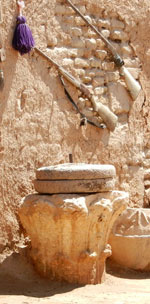Architecture in Eastern Turkey
 I came to Mexico originally because I love to travel… meet new people, experience new cultures, see new horizons. Of all the places I’ve traveled, I chose Mexico as my home. But that doesn’t mean my wanderlust is gone. Luckily for me and so many of us, I can run my business thanks to the Internet, and still indulge my desire to see other parts of the world.
I came to Mexico originally because I love to travel… meet new people, experience new cultures, see new horizons. Of all the places I’ve traveled, I chose Mexico as my home. But that doesn’t mean my wanderlust is gone. Luckily for me and so many of us, I can run my business thanks to the Internet, and still indulge my desire to see other parts of the world.
I have been away from the office now for more than a month. The work goes on at Tierra Yucatan, of course, and the wonders of modern communications have let me stay on top of business from some fairly distant parts of the world. For the last few weeks of June that distant part of the planet was Eastern Turkey, on the borders with Syria and Iran. Eastern Turkey is less developed than the western part of the country and is filled with fascinating people and cultures. People come to this austere landscape of desert and mountains to get a glimpse of ancient cultures through architecture, museums and the living descendants of those cultures… much like they do when they come to the Yucatan. Ruins and sites date back to before Biblical times… the Book of Genesis in the Old Testament mentions that Abraham and his family lived in Harran for awhile, and this is a city that I visited.
Of course, although the history and archaeology always fascinate me, I found myself consistently wandering off in the direction of interesting architecture. I thought you might like to see some photos and hear about what I saw there.
The mud brick and rock “beehive houses” of Harran (also called Altınbaşak) are quite unique in Turkey, but I did learn that there are villages in Syria that still are using this method of construction. The house in the photograph here (and in the photo gallery on our Facebook page) consists of 26 rooms! Each room has a conical roof built of mud brick with no mortar. The bricks are placed so that each is slightly overlapping the one below. Gravity and I’m convinced a little bit of prayer hold them all in place as the cone narrows towards the top. A small  opening at the tip of the cone allows hot air to vent, and I found the whole house to be deliciously cool and breezy. Even the kitchen, pictured below and to the right, was cool enough. And you can see from the photo how the bricks are the basic building element, which are then covered over with mud. There are not as many colors in the architecture here as we have in Merida – mostly earth tones and the villages blend into the landscape… this architecture is more analogous to the Mayan huts that you see in the countryside outside the city.
opening at the tip of the cone allows hot air to vent, and I found the whole house to be deliciously cool and breezy. Even the kitchen, pictured below and to the right, was cool enough. And you can see from the photo how the bricks are the basic building element, which are then covered over with mud. There are not as many colors in the architecture here as we have in Merida – mostly earth tones and the villages blend into the landscape… this architecture is more analogous to the Mayan huts that you see in the countryside outside the city.
These houses are really family compounds, built around a central courtyard where all family activities take place. As the family grows and children marry, new mud brick rooms are easily added and the house expands. If you feel like enjoying the experience, there is even a compound in the village that serves as a simple hotel where visitors can spend a night or two! I found the architecture fascinating, but was happy to sleep in my more modern hotel.
The architecture in Harran is so different from our colonial architecture in Merida, but I noticed some similarities to both the colonial homes and the Maya houses. The houses in Turkey and the colonial homes of Merida are often centered around a courtyard, the place where the family gathers and enjoys visiting. That is true here in the Yucatan as well, where our courtyards are often the most beautiful place in the home… totally private and hidden from the public eye. The Mayans, on the other hand, seem to build family compounds by having a group of separate oval-shaped houses that all share the same property and often have a common kitchen. Merida doesn’t have the same rug tradition as the Middle East, but in Merida’s colonial homes, we adorn our floors with tapetes (rugs) of tile. Everyone around the world loves a beautiful floor! And it is certainly true that a beautiful handmade Kilim rug looks beautiful in both places!
Posted: July 6th, 2011 under Global Travels.
